Each weekend in the winter Brazos Bend State Park offers at least three
free nature programs conducted by the rangers, volunteers, or guest
speakers. I think all of the Texas State Parks do this.Last year we
attended five or six programs that were very interesting, so one of the
first things I did when we got here this year was to see what was on the
agenda for our first weekend.
Ah -- there's a new topic:
Doris Mager and her birds of prey, which are also called raptors.
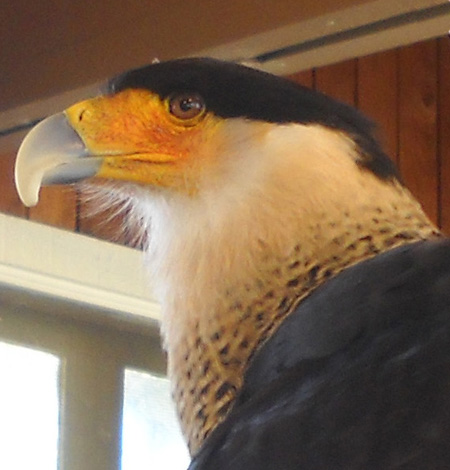
Doris' magnificent crested caracara, a
large injured raptor she rescued
and rehabilitated. It has lived to the age of 34
years old in her care.
We'd never heard of Doris Mager AKA The Eagle Lady but we quickly
learned that her presentations are not to be missed. Rilla, fellow
campground host
and avid birder next door to us, advised us to get there early because the dining hall would
fill up.
We did (sat near the front, on the aisle so I could take pictures),
it did (the large room was packed), and we are very glad we went. All of
the photos in this entry are from Doris' lecture.
WHO IS DORIS MAGER?
This energetic, quick-thinking 82-year-old lady travels around the
USA in her Class B recreational vehicle with several large raptors to
spread the word about birds of prey. She has devoted much of her life to
their protection.
This weekend alone she gave four presentations at Brazos Bend;
over a hundred people attended ours, and I'd guess the others were just
as full. Next week she'll speak in a
different park or other venue, such as a school or wildlife center.
She's been doing this for 35 years and plans to continue educating
the public about raptors until she is no longer physically able to do
so.
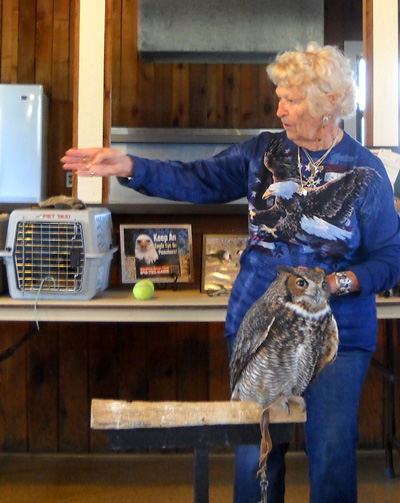
Doris began her presentation
while stroking the head of her
great horned owl, ET, who loved
the attention.
Rilla pointed out Doris' RV in our campground loop one day this week.
Later that afternoon I saw Doris outside her camper when I was riding my
bike. I stopped to introduce myself and say hi. She's a delightful woman to
talk with one-on-one and gives lively lectures, involving the audience
as much as possible with her beautiful birds.
Back in 1989 Doris founded SOAR -- Save Our American Raptors
-- a non-profit rehabilitation and educational organization.
SOAR rehabilitates injured raptors, which include eagles, hawks,
falcons, osprey, owls, vultures, and kites. Many of the birds are able
to be released back into the wild after they have healed adequately.
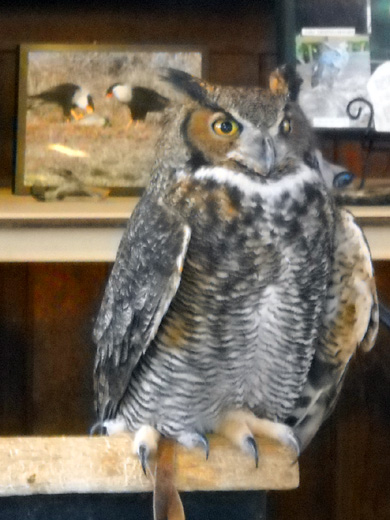
This is ET. Guess how much this
plump fella weighs (answer below).
Doris travels with birds that cannot be released back into the wild
either because of their previous injuries or the amount of human
imprinting they've had. She brought with her four raptors on this trip
-- a great horned owl, a little screech owl, a large crested
caracara, and an American kestrel.
It was simply fascinating to watch the birds and listen to Doris'
stories about them.
The two dozen elementary school-age kids in the audience were almost
as captivated by her talk as the adults, although the youngest ones were
squirming after an hour. I think they were glad they stayed until the
end, however, when they experienced the dramatic finale to the
presentation.
WHY IS SHE CALLED "THE EAGLE LADY?"
Back in the early 1960s Doris was working with the Audubon Society in
Florida. Someone brought in an injured red-tailed hawk. Doris took the
bird home, nursed it back to health, and released it into the wild.
That was the start of her legendary career in the world of raptors.
As word of her success grew, people brought more and more injured
birds into the office for her to rehabilitate. At one time she had seven
injured eagles in her back yard.
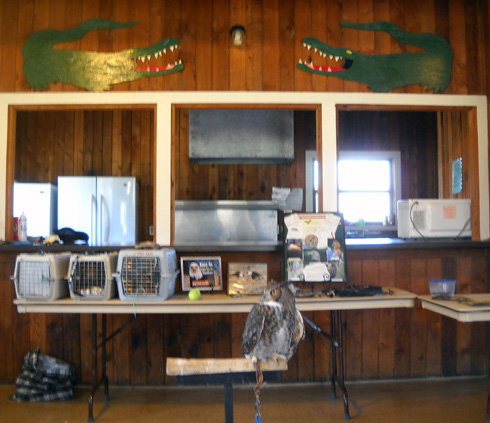
ET waits for the lecture to
begin. He's done this drill hundreds of times.
The Audubon Society realized there was a need to build a facility for
this rehabilitation so they launched a fund-raising campaign.
Construction began but as often happens, the organization
came up short of $$$$ before the building was finished.
Resourceful Doris came up with a
unique public relations stunt to raise the remainder of the money: she located an
abandoned eagle's nest and lived in (next to?) it for a week!
That got people's attention, of course. The necessary funds were
donated and Doris earned the new nickname, Eagle Lady.
Ya
gotta admire a woman with that much spunk and devotion to a worthy
cause.
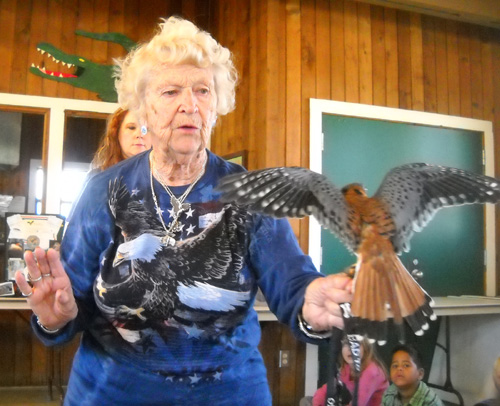
Doris encourages her American kestrel
to open its wings so we can see its coloring.
In 1983 Doris left the Audubon Society and founded SOAR. She has
continued protecting and rehabilitating birds of prey and educating the public
about them ever since.
There are several regional chapters of SOAR but I haven't yet located
the original one online. Nor have I been able to access the Texas Parks
& Wildlife's page announcing Doris' presentations in that state's parks
this year.
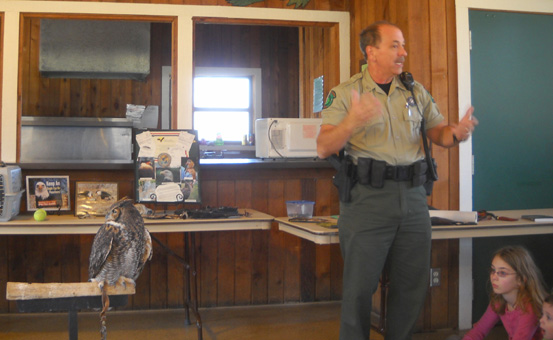
Ranger Dave introduces Doris
before her presentation yesterday.
I did find several regional SOAR links in a web search, and here's a
link to a web page about Doris' 2010
Brazos Bend presentation by a birder named Bruce. He attended one of her
lectures in 2009 and was encouraging folks to attend the upcoming shows.
His bird photos are much better than mine!
Credit where credit is due, and all that.
DORIS' PRESENTATION
Jim and I attended the first of two lectures Doris gave yesterday at
Brazos Bend. She had two more presentations on Friday and Sunday.
Despite all the energy it takes to conduct each lecture with four
active birds (plus one of Ranger Dave's birds this weekend), all their accoutrements, folks who have questions and want
to get too close to take pictures, and fidgeting kids sitting on the
floor right in front of her, Doris was patient, upbeat, and didn't get
rattled easily.
Neither did her 28-year-old
great horned owl, ET, who patiently clung to his perch
for about twenty minutes before the program began. Guests were permitted
to get within a few feet of him to take photos and peek into the cages
of the other birds that were waiting their turn in the spotlight:
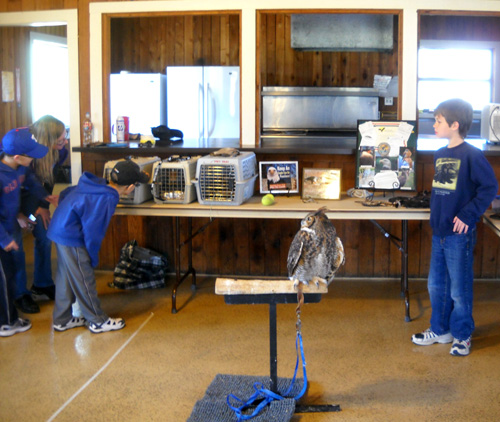
Jim and I got there early enough that I had a pretty good position on
the aisle to take pictures during the presentation.
Like the others, I got to practice on ET. He was both willing and
photogenic.
Three park staff members assisted Doris with her program at Brazos
Bend: park naturalist Dave, manager-in-training Ted, and the park
superintendent's wife, Jennifer.
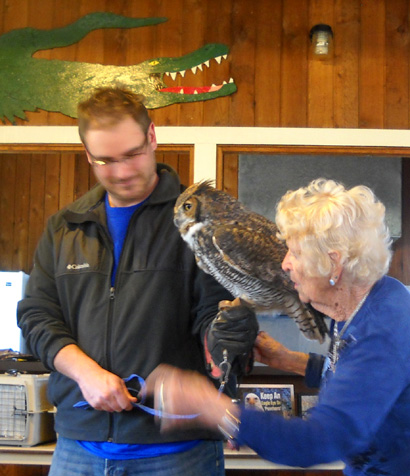
Ted holds ET while Doris makes a
point.
Doris' description of each bird's history, habits, and physiology was
interesting.
ET, for example, looked quite plump with all his feathers. We were
amazed to find out he has hollow bones and weighs only three pounds!
From the size of him, I guessed about ten pounds.
It was also cool to watch ET swivel his head around to about 180
degrees so he could see what was going on around him:
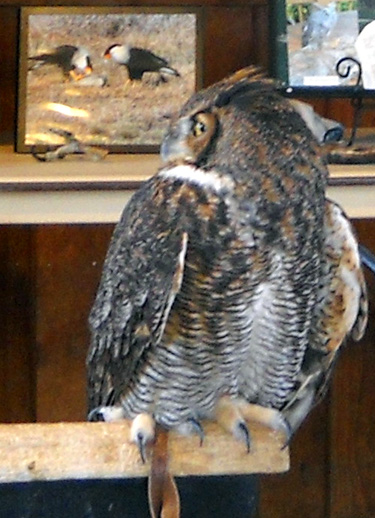
Each time he whipped his head around like this, I almost wondered if it
would go full circle!
After Doris returned ET to his cage she brought out a little
eastern
screech owl. I don't have a picture of it. If you want
to see what they look like, click on that link; the Peregrine Fund has some
good information and photos on screech owls and other raptors.
Next up were a male and a female
American kestrel, shown below with
Doris and Jennifer:
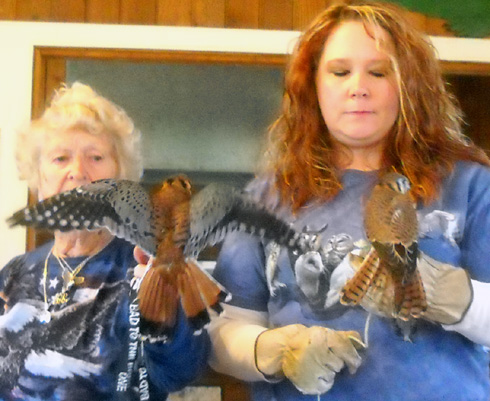
The male bird on the left belongs to
Doris; the female belongs to Ranger Dave, the park naturalist.
It was interesting to see the differences in the attractive coloring of
the two birds. The male has blue on its wings, while the female is
mostly brown.
The American kestrel is a type of falcon that is found throughout most
of North, Central, and South America. It is the smallest and most
numerous of the North American falcons.
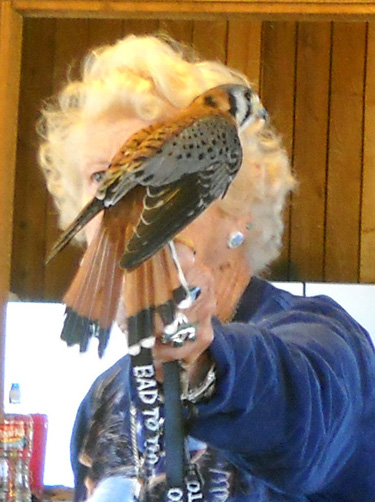
Near the end of the program Doris said she needed two volunteers from the audience
to help her with the last bird. When no one immediately raised a hand, she pointed at me
since I was close. I hesitated a bit too long, not knowing what I was in for!
My bad. You snooze, you loose.
A young lady and young man from the audience then jumped at the
opportunity to help Doris with her magnificent
crested caracara:
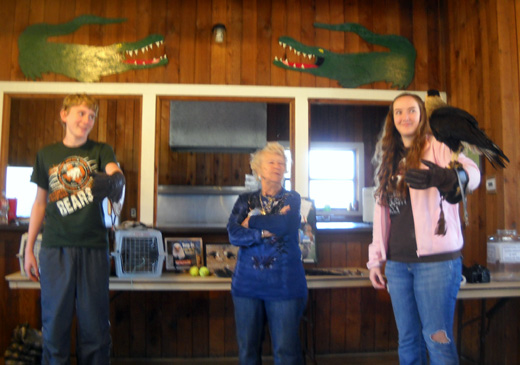
Doris fitted them each with arm protection, showed them how to hold
out their arms so the caracara could land and perch there, and had them
each call the bird to their side. The bird flew back and forth between
them a couple of times.
While that was going on, Doris talked about this caracara and the species
in general. The rehabilitated 34-year-old raptor
has lived with Doris for many years. Birds in captivity often live
longer than the same species in the wild.
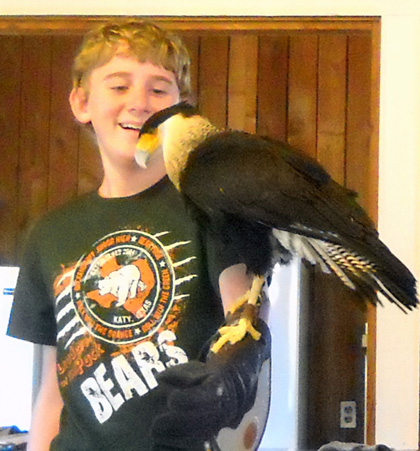
Caracaras are described as a "tropical falcon version of a vulture."
They live in the southwestern U.S. and Florida, as well as Central and
South America. They usually eat carrion but don't turn down a tasty live meal if it's
available. The bird's common name derives from the "cara-cara" sound it
makes.
Doris asked the young man to walk through the audience so everyone could
get a closer look at the magnificent bird:
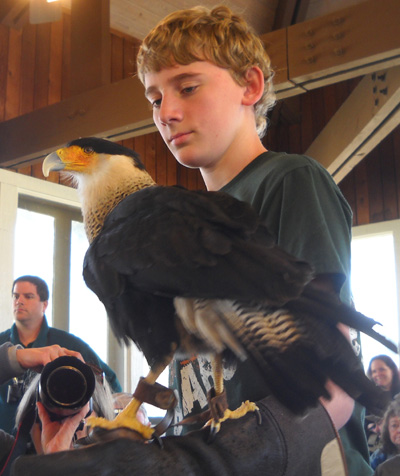
I included a close-up of its attractive head at the top of this entry.
SHOW-STOPPER
Doris and Dave then wowed
the audience with the grand finale.
Ranger Dave called the caracara to the back
of the dining hall. We all kind of gasped as it flew right over our
heads as instructed. The bird has a wingspan of about four feet, and we
were indoors!
Then Dave sent the caracara back to the volunteers at the
front of the room:
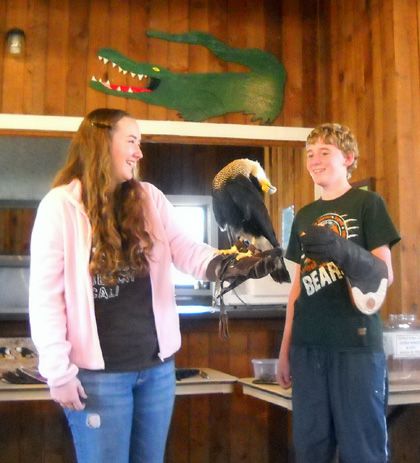
You can tell they were having fun. So were the little kids and
everyone else in the audience. Live demonstrations don't get much
better than that!
Dang it. Wish I'd been up
there to experience that. If we're ever at one of the parks again when Doris
does this program I'll go back to hear another presentation -- and jump
at the
opportunity to assist!
After the lecture guests were invited to come up to hold one of the
birds and have their photos taken for a mere $5 each. The line was so
long that we decided to pass. Shoulda jumped on that real fast, too, or
gone back to one of the two remaining lectures.
Next entry: our second week at Brazos Bend
Happy trails,
Sue
"Runtrails & Company" - Sue Norwood, Jim O'Neil,
and Cody the Ultra Lab
Previous
Next
© 2011 Sue Norwood and Jim O'Neil















